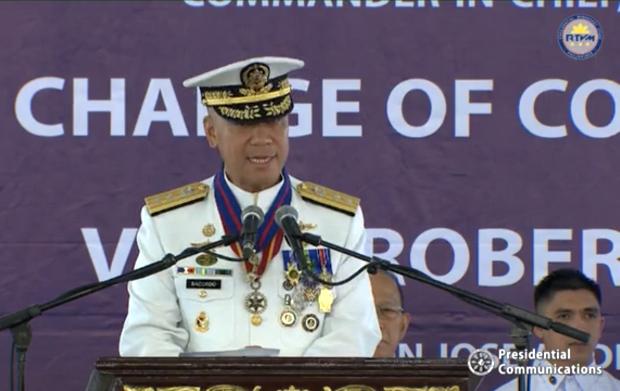‘Modern mindset for modern assets’: New Navy chief sets priorities

Rear Adm. Giovanni Carlo Bacordo, the new Philippine Navy flag officer in command. (Photo from an RTVM video)
MANILA, Philippines — The new flag officer in command of the Philippine Navy has vowed to make its existing and upcoming platforms to be efficient through time in order to truly fulfill their mandate.
“I will implement programs that will ensure that these new defense capabilities will remain to be capable through time, that not only we will have modern platforms, but also modern systems and modern mindsets to ensure that we will continue to fulfill our mission,” Rear Adm. Giovanni Carlo Bacordo said in the change of command ceremony at the Navy headquarters in Manila.
The former commander of the Philippine Fleet became the 38th flag officer in command on Monday, replacing Vice Adm. Robert Empedrad, who retired from the service after 37 years. President Rodrigo Duterte led the turnover ceremony.
Bacordo, in his speech as he took the highest office of the sea service, set three priority programs and how they can be achieved:
1. Sustainment suite for new platforms, weapons and sensors of the fleet and the Marines
Article continues after this advertisementThe new Navy chief said this priority can be achieved through capacitating the Naval Sea Systems Command (NSCC), the unit which is in charge of the maintenance of the weapons, communications and electronic systems and hull, machinery and electrical systems…To capacitate the NSSC means to capacitate the fleet and the Marines, he said.
Article continues after this advertisementMateriel and facility requirements must also be included in every modernization package. As the Navy acquires more ships, there should also be a program for drydocks that can accommodate the ships. There should also be a program for special tools and test equipment, a program for simulators, etc. Naval port facilities should also be developed.
2. Strict implementation of specialization for officers and enlisted personnel skills
Bacordo said there should be a strict observance of the fields of specialization and selective recruitment, wherein they would only accept applicants that the Navy needs like graduates of engineering, electronics and computer-related courses.
“Because of the present mindset that only officers who have completed their command of the Navy vessels and command of Marine battalions can advance to flag rank, the overall effect is that everybody wants to command ships and battalions, that we have never developed a high proficiency in the support to warfare and staff specializations like personnel, plans, logistics, finance, cyber warfare, education and training,” he said.
3. Modernizing the mindsets of every sailor and marines
Bacordo said all “legacy vessels” would be decommissioned by the first semester of 2021. Modernizing the mindset of sailors and Marines is challenging because of “decades of exposure to legacy capability.”
There should also be heavy investment in personnel through training, selective recruitment, strict observance of attrition policies, among others. He also stressed the need to modernize base facilities.
Past lessons
Bacordo said his priorities were driven from Navy’s past experiences, where new defense platforms did not guarantee that it will stay in fighting status in the next 5 to 10 years. Some of his examples were:
— The three Del Pilar-class vessels were all fitted with two marine gas turbines, a new technology to the Navy. Yet today, only two of the six marine gas turbines are functioning.
— Three years after the Navy received the three Jacinto-class patrol vessels from the British Hong Kong squadron in 1997, not a single 76mm Oto Melara gun of the ships was firing. Not a single loiter drive of these vessels was operating. At that time, it was the most modern of the Navy platforms.
— Port facilities of all their naval bases and stations are not capable of accommodating the Navy’s strategic vessels — the Del Pilar-class vessels, two landing docks (LDs) and the BRP Conrado Yap (PS-39).
“These vessels instead, make the commercial ports as its home base. Where will our future frigates, LDs, corvettes, and OPVs (offshore patrol vessels) be home-ported now?” Bacordo said.
“Given this trend, all these modernization efforts will go to waste unless the Philippine Navy further develops some of its systems in place.”
/atm